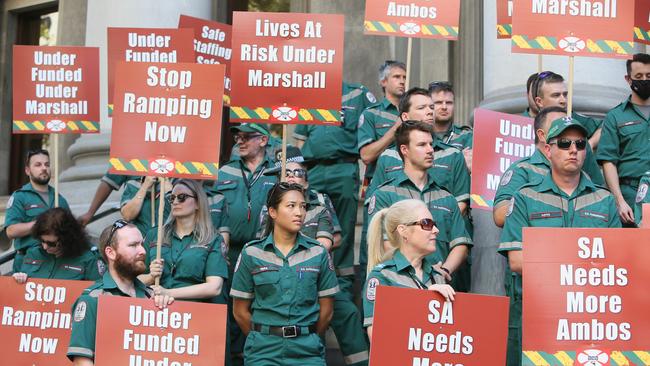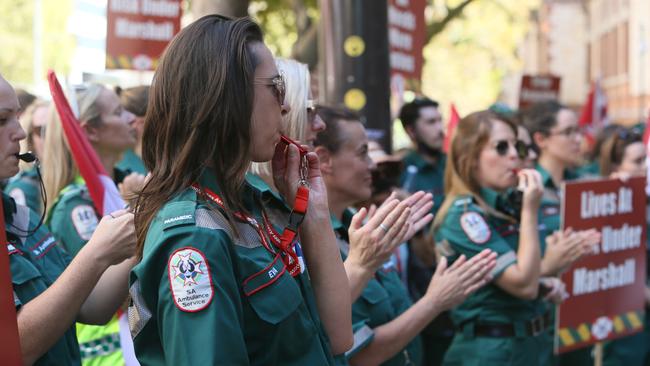Ambulance Employees’ Association reaches deal to end dispute with State Government – but it must be ratified by members
The ambulance officers’ union and the State Government have forged a deal in their long-running dispute – now it goes to ambos for a vote.
SA News
Don't miss out on the headlines from SA News. Followed categories will be added to My News.
An extra 74 ambulance officers would be hired and paramedics’ rosters overhauled to reduce 12-hour shifts under a peace deal to settle a long-running dispute over resources.
The major breakthrough, which is subject to rank-and-file paramedics’ approval, involves ambulance officers agreeing to work more shorter shifts and stagger start and finish times.
But talks will continue on a key State Government demand of paramedics taking meal breaks at the nearest ambulance station, rather than driving to their home base.
The deal was hammered out after a mediation meeting on Monday between the Ambulance Employees Association (AEA) and the government at the SA Employment Tribunal.
In a bulletin to members, the AEA branded as disgraceful the “huge effort” put into “what could have been achieved six weeks ago … employ more staff and we will consult on additional roster models and ways to improve crib performance (returning to home stations for meal breaks)”.
But the two sides swiftly differed over the roster agreement, with the government emphasising it would shift “the balance towards increased reliance on other existing short shift arrangements” while the AEA argued it was not wholesale reform.
Premier Steven Marshall has faced intense pressure to resolve the dispute, which involved the AEA demanding more resources to help relieve overworked staff and improve chronic ramping outside public hospital emergency departments.

Revealing details of the agreement, Treasurer Rob Lucas said the extra 74 full-time-equivalent ambulance officers would be in addition to an extra 187 FTE employed from mid-2018 to mid-2020.
Of the extra officers, up to 24 will be allocated to country stations, including Port Augusta, Whyalla and Ceduna.
The union has agreed to stop all industrial action and complete the roster reform model by June 30.
Rosters will feature eight, 10, 10.5 and some 12-hour shifts. The agreement involves a concession that the new 10.5-hour shift will involve only one meal break, rather than two previously required for shifts of more than 10 hours.
Mr Lucas said the government now had concluded deals with teachers, nurses, police and ambulance officers by “negotiating a fair compromise and standing firm”.
“We recognise the enormous contribution our hardworking ambos make in our community and this offer will help ensure they can deliver the best possible service to South Australians, while reducing fatigue and improving work-life balance,” Mr Lucas said.
“The government has always maintained its commitment to compromise, offering more ambulance officers and paramedics conditional upon the union committing to important roster and meal break reforms and the end of industrial action
“We know that more staff alone is not going to deliver the safest and highest quality ambulance service and help solve the issue of ramping, which is why we need these sensible industrial reforms in addition to the significant investment we are making in our emergency departments.”

In the bulletin to members, AEA state secretary Phil Palmer says the association executive believed the agreement, signed yesterday subject to members’ ratification, was “
is the first of several steps in resolving the critical resourcing shortfalls facing the ambulance service and the subsequent risk to public safety”.
Mr Palmer says the executive was acutely aware the 74 extra staff would provide some relief but did not resolve workload issues. Depending on roster configuration, 50 extra ambos would represent three to four extra ambulances.
“Three or four ambulances will not be sufficient in fully resolving the public
safety risk borne of inadequate resourcing,” he says.
Mr Palmer stresses the AEA has committed to roster reform only “on additional roster models”.
The discussions about roster models such as an increased reliance on existing shorter shift
arrangements only applies to additional roster models,” he says.
“The AEA have not committed to wholesale roster reform of all rosters and only committed to
roster reform for additional roster models. Members currently working 12-hour rosters are not
affected by this commitment.”
Mr Palmer says the discussions about crib reform, or taking breaks at home ambulance stations, would start by May 14, which might overlap with enterprise bargaining talks.
Mr Palmer in March revealed the government had increased its offer of 50 extra staff to 70, then declared the union would not accept the deal.
The AEA and government were ordered into mediation earlier in March by president of the SA Employment Tribunal Justice Steven Dolphin, when the union took industrial action after the government failed to respond to an ultimatum to deliver more resources.
Paramedics had stopped charging patients who waited too long for ambulances or were ramped at hospitals.
As part of the industrial action, they did not bill patients who experienced long ambulance response times, those who were ramped and those who were tended to by an on-call ambulance.
Paramedics joined MFS firefighters and SA Power Networks workers in a march through Adelaide’s CBD on April 1, demanding more funding from the State Government.




